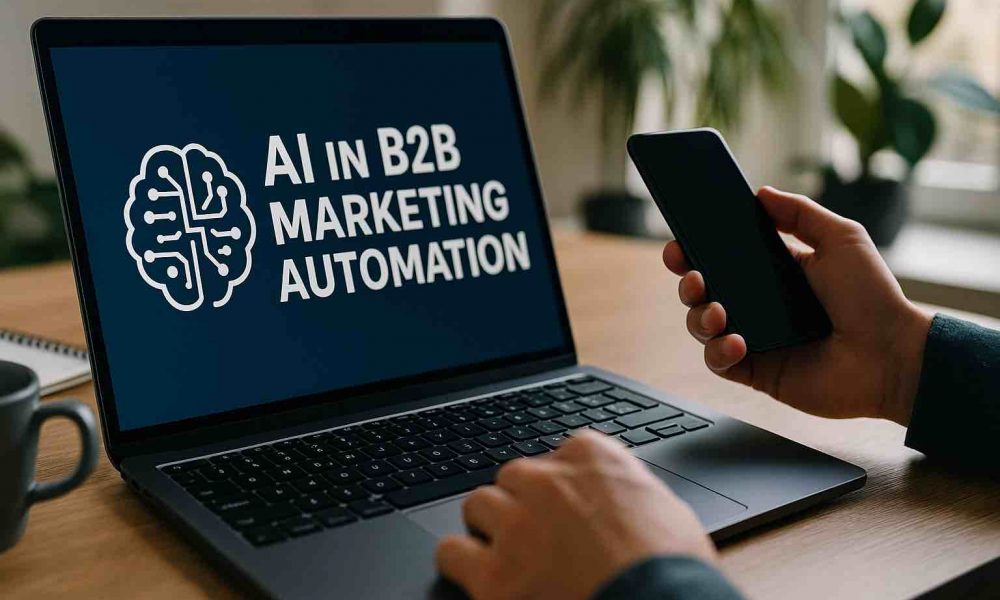AI Automation for B2B: Strategies to Improve Your Business Performance
AI automation in the B2B industry presents an essential chance for companies to boost their efficiency. By enhancing procedures and enhancing decision-making, companies can attain considerable performances. The effective integration of AI calls for mindful factor to consider of different variables. Comprehending which areas to automate and picking proper devices are simply the start. The capacity for makeover increases critical questions concerning execution and recurring examination. What techniques will guarantee enduring success in this evolving landscape?
Comprehending AI Automation in B2B Context
As companies progressively seek efficiency and technology, comprehending AI automation in the B2B context ends up being crucial. AI automation leverages advanced innovations to simplify processes, enhance decision-making, and improve general productivity. By integrating AI tools, business can enhance procedures such as supply chain management, consumer relationship administration, and information analysis. These innovations can analyze large amounts of data quickly, providing workable insights that drive strategic campaigns. In addition, AI-driven automation minimizes human error and releases up workers to focus on even more complicated tasks. By promoting collaboration in between human intelligence and equipment capacities, organizations can achieve an affordable side. Inevitably, comprehending AI automation is crucial for B2B companies intending to flourish in a significantly electronic marketplace.
Determining Locations for Automation
In the quest for reliable AI automation in B2B, it is important to recognize details areas where automation can generate substantial advantages. This includes assessing task monotone, checking out opportunities for information handling, and pinpointing operations traffic jams. By concentrating on these aspects, organizations can improve procedures and enhance productivity.
Job Monotone Assessment
Task monotone analysis plays a crucial function in recognizing locations ripe for automation within B2B procedures. Minarik AI. This process entails evaluating everyday tasks to figure out which are repetitive and time-consuming, thereby hindering productivity (Growth Systems For B2B). By looking at process, organizations can determine specific features that call for excessive hand-operated input, such as data entrance, billing processing, or client follow-ups. Recognizing these recurring jobs permits companies to assign sources better, improving overall effectiveness. Furthermore, automation can reduce human mistake, improve procedures, and maximize staff members to focus on higher-value tasks. Performing a comprehensive job monotone assessment equips B2B organizations to embrace targeted automation techniques, eventually driving boosted performance and competitive advantage in the marketplace
Information Handling Opportunities

Process Bottleneck Identification
Identifying operations traffic jams is an important action in understanding the full benefits of automation within B2B organizations. These bottlenecks usually show up as delays, source restraints, or ineffective procedures that hinder performance. To properly determine these locations, businesses can perform extensive analyses of their process, making use of metrics such as cycle time and throughput. Involving workers in discussions regarding discomfort points can likewise provide beneficial insights. Organizations can prioritize them based on influence and expediency for automation when traffic jams are identified. By purposefully resolving these ineffectiveness, B2B companies can improve procedures, boost partnership, and ultimately boost general performance. This proactive technique to workflow evaluation lays the groundwork for successful automation initiatives that drive organization development.
Picking the Right AI Tools and Technologies
As organizations significantly turn to AI to boost their procedures, choosing the right tools and technologies becomes necessary for achieving wanted end results. Organizations needs to assess their specific requirements and purposes, taking into consideration elements such as user-friendliness, scalability, and compatibility. A detailed market analysis can help identify leading AI remedies customized for their industry. Furthermore, organizations should assess the technological infrastructure needed to support these tools, making sure seamless assimilation with existing systems. Information protection and conformity with guidelines are additionally essential considerations that influence device selection. By focusing on these requirements, business can make educated choices that drive performance and performance, ultimately leading to enhanced service performance. The appropriate AI devices equip companies to introduce and keep a competitive side in the market.
Creating a Critical Application Plan
A successful strategic application prepare for AI automation in B2B calls for plainly specified key objectives. In addition, companies should assess their current abilities to recognize voids and possibilities for enhancement. Constant tracking and modification of the strategy will assure positioning with developing business demands and modern technology developments.
Specify Trick Purposes
To assure effective AI automation in B2B environments, specifying vital objectives is important for developing a calculated application plan. Organizations must determine specific, measurable objectives that straighten with their total business approach. This clearness offers a roadmap for the automation process, guaranteeing that initiatives are concentrated on locations that will certainly produce the highest possible influence. Secret objectives might include enhancing operational performance, enhancing client satisfaction, or enhancing revenue. Establishing these goals enables teams to prioritize resources successfully and track progress over time. Furthermore, clear goals promote better communication amongst stakeholders, cultivating partnership and placement throughout the organization. Inevitably, distinct objectives act as the structure for a robust AI automation approach that drives organization performance.
Assess Current Capabilities
Before executing AI automation, organizations must completely evaluate their existing abilities to recognize toughness and weaknesses. This evaluation includes checking out existing technologies, workforce abilities, and functional procedures. By carrying out an in-depth audit, businesses can identify locations that call for renovation or financial investment. Organizations should also consider their information monitoring practices, as the quality and access of information are vital for successful AI assimilation. Comprehending the existing technical landscape allows companies to straighten their sources and abilities with their strategic purposes. In addition, it is important to evaluate company culture and preparedness for modification, as these aspects greatly affect the fostering of AI options. This evaluation offers as the foundation for establishing a calculated application strategy that optimizes the potential of AI automation.
Monitor and Adjust
Carrying out AI automation needs a dynamic strategy that stresses constant surveillance and change. Companies have to create a critical application strategy that incorporates normal analyses of AI performance against predefined metrics. This entails monitoring essential efficiency indicators (KPIs) to analyze the performance of automation solutions. By evaluating data, companies can determine locations for renovation and fine-tune their AI systems accordingly. Engaging with stakeholders throughout the process guarantees that the automation lines up with organization purposes and individual demands. In addition, promoting a society of versatility enables business to react swiftly to altering market conditions and technological developments. have a peek at these guys Growth Systems For B2B. Ultimately, ongoing surveillance and change not just boost functional effectiveness yet likewise drive continual company performance in the competitive B2B landscape
Ensuring Data High Quality and Combination
As organizations progressively count on AI automation in B2B processes, making certain information top quality and assimilation ends up being vital for success. High-grade information is vital for accurate analytics, informed decision-making, and efficient consumer involvement. Data should be cleaned, standard, and confirmed to remove errors and incongruities that might bring about misdirected insights. Furthermore, smooth combination across different platforms and systems is imperative; disparate data silos prevent automation initiatives and lower functional performance. Organizations needs to take on robust data governance frameworks and use advanced devices to help with information combination while maintaining top quality standards. By prioritizing these elements, businesses can boost their AI automation efforts, inevitably causing enhanced performance and a competitive advantage in the B2B landscape.
Gauging Success and ROI of AI Initiatives
How can companies successfully determine the success and return on investment (ROI) of their AI initiatives? To evaluate effectiveness, companies ought to establish clear, measurable objectives straightened with strategic goals. Trick performance indications (KPIs) such as cost financial savings, profits development, and efficiency enhancements can give beneficial insights. Organizations usually conduct standard analyses before applying AI, enabling them to compare pre- and post-implementation metrics. Additionally, analyzing consumer fulfillment and engagement can reveal the influence of AI on customer experience. Regularly assessing these metrics helps in refining AI techniques and making sure positioning with organization goals. By using a structured method to dimension and assessment, companies can accurately evaluate the performance of their AI initiatives and make notified choices about future financial investments.
Getting Over Obstacles in AI Fostering
Although many companies recognize the capacity of AI to transform their procedures, they usually run into considerable obstacles during adoption. Secret obstacles include a lack of skilled workers, which hampers the effective execution and administration of AI modern technologies. Organizations additionally deal with assimilation concerns, as existing systems may not work with new AI solutions. Additionally, problems regarding information personal privacy and protection can result in resistance in completely welcoming AI capabilities. Resistance to alter from workers can even more make complex the shift, necessitating extensive training and communication approaches. To get rid of these challenges, companies need to buy skill development, warranty robust information administration, and promote a society that welcomes innovation, inevitably leading the way for successful AI integration and improved service performance
Regularly Asked Questions
How Can AI Automation Improve Client Partnership Administration in B2B?
AI automation can boost consumer partnership management in B2B by streamlining communication, offering tailored interactions, evaluating consumer information for understandings, automating follow-ups, and boosting response times, inevitably cultivating stronger partnerships and driving sales growth.
What Industries Benefit Most From AI Automation in B2B?
Production, money, healthcare, and logistics markets benefit most from AI automation in B2B. These sectors utilize automation to simplify processes, improve data analysis, improve consumer communications, and eventually boost functional efficiency and profitability.
Exactly How Does AI Automation Effect Staff Member Responsibility in B2B Companies?
AI automation changes worker functions in B2B companies by streamlining tasks, lowering recurring job, and making it possible for team to focus on critical campaigns. This shift boosts efficiency and fosters a society of technology and adaptability.
What Are the Expenses Connected With Executing AI Automation?
The prices linked with implementing AI automation consist of first software procurement, infrastructure upgrades, training expenditures, recurring upkeep, and prospective assimilation difficulties. Minarik AI. Business need to also think about long-lasting functional shifts and staff member adjustment expenditures in their economic planning
Exactly How Can Businesses Make Certain Moral AI Usage in Their Procedures?
Services can assure ethical AI use by establishing clear guidelines, advertising transparency, carrying out normal audits, involving varied stakeholders, and focusing on data privacy. Continual training and awareness programs further improve understanding and adherence to ethical methods.
